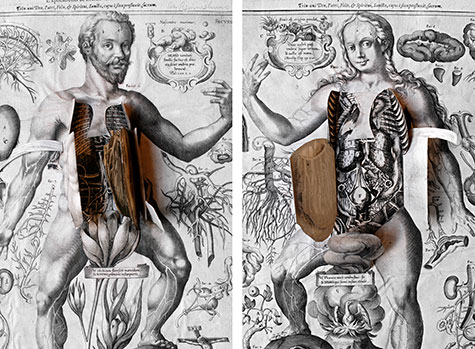
A 600-pound aluminum sphere swings from the ceiling in Washington University in St. Louis’ Mildred Lane Kemper Art Museum. “Your Imploded View” (2001) is the creation of Olafur Eliasson, a Danish-Icelandic artist who employs elemental materials — including light, water and air temperature — to create large-scale sculptures and installations.
Often collaborating with architects and designers — as well as mathematicians, climate scientists and mechanical engineers — the Berlin-based artist is emblematic of the rich, reciprocal relationships that increasingly define cutting-edge work in a wide variety of fields, said Patricia Olynyk, the Florence and Frank Bush Professor and director of the Graduate School of Art in the Sam Fox School of Design & Visual Arts.
“Eliasson’s practice underscores that the arts inspire and inform other disciplines, and that other disciplines inspire and inform the arts,” Olynyk said. “Inspiration for scientists, humanists and artists alike derives from our ever-changing understanding of a world continually challenged by globalization, technological advancement and shifting socio-political landscapes.
“These challenges are open-ended and complex and therefore resist any singular approach or resolution,” Olynyk said. “Both local and global problems continue to spring from likely and unlikely sources, and confronting them requires expertise and creative problem-solving.”
a2ru
An artist who frequently investigates the intersections of art and science, Olynyk is now helping to lead a national task force developing communication strategies and case-making documents for the Alliance for the Arts in Research Universities (a2ru).
Launched in 2012, with WUSTL as a founding member, a2ru is a partnership of almost 30 institutions from across the United States. Designed to advance the role of the arts in research universities, the group is a direct outgrowth of a 2011 meeting hosted by the University of Michigan’s ArtsEngine initiative. Attendees included more than 150 university presidents, provosts, deans, directors and other faculty and administrative leaders.
Representing WUSTL were Olynyk, Sam Fox School Dean Carmon Colangelo and Edward S. Macias, PhD, then provost and executive vice chancellor for academic affairs.
“Art practice and the making of art represent a unique form of knowledge production,” said Colangelo, who also serves as the E. Desmond Lee Professor for Collaboration in the Arts. “Our mission is not simply a matter of utility, of making other disciplines more creative. Rather, it is to understand the intrinsic value of the arts themselves and the value they can bring to interdisciplinary research endeavors.”
Later this month, a2ru will host an “Emerging Creatives Student Conference” at Stanford University. Bruce Lindsey, dean of architecture in the Sam Fox School, will be among the speakers. Six WUSTL students, representing both the Sam Fox School and the School of Engineering & Applied Science, will attend.
Vertical seminar
Meanwhile, back on campus, Olynyk is preparing a vertical seminar about “The Role of Arts Practice in the Research University.”
Slated for the fall semester — and supported by a grant from the Mellon Foundation — the seminar will explore original creative work produced in collaboration with high-level research activity, as well as the integration of arts practice across research disciplines.
“The research university is incomparably equipped to facilitate creative and scholarly exchange as it aligns conventional approaches with now-established interdisciplinary research and curricular practice to support new and challenging endeavors as we move collectively into the unknown,” Olynyk said.
The seminar is open to scholars and practitioners at all academic levels, from junior and senior faculty to postdoctoral fellows to dissertation and Master of Fine Arts students. The Mellon Foundation grant supports release time for participating faculty, seminar stipends for dissertation students, and a symposium at the end of seminar.
Those interested in joining should submit a letter of no more than three pages describing a project they intend to pursue over the course of the seminar, as well as the relationship between the seminar and their own research. (In addition, dissertation students should ask their supervisors to send a letter of reference about their work.)
Applications should be submitted directly to Olynyk at olynyk@samfox.wustl.edu. The deadline is Jan. 30.